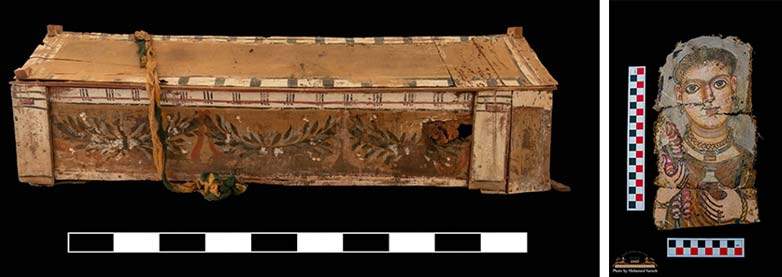Egypt, new Fayyum portraits discovered. The last such discovery was in 1910
Major archaeological discovery in Egypt where the archaeological mission working from Gerza in the Fayyum region has identified a huge funerary building from the Ptolemaic and Roman periods, as well as a number of new Fayyum portraits, during the mission’s 10th season of excavations this month. It is particularly the discovery of the new portraits that is of interest, since these paintings, executed on wooden boards and used to cover Egyptian mummies in the Roman period, are not many (about six hundred are known), are among the rare pictorial evidence from antiquity (as well as among the best preserved), and are striking for their high degree of realism. The Egyptian ministry, however, did not specify how many portraits were found.
Breaking the news of the find was Egypt’s Ministry of Antiquities and Tourism . The secretary general of the Supreme Council of Antiquities, Mostafa Waziri, explained that what was discovered at the site illustrates different levels of quality of the embalming process during the Ptolemaic and Roman eras (it was indicative of the economic and social status of the deceased), since it ranges from burials with high-quality embalming to simpler burials. Findings also include a rare terracotta statue of the goddess Isis found inside a sarcophagus, as well as a group of documents written on papyrus, with inscriptions in Demotic and Greek characters indicating the social, economic and religious conditions of the region’s inhabitants at that time.
The head of the Central Department of Egyptian Antiquities in Central Egypt, Adel Okasha, in emphasizing the multiplicity and diversity of artifacts that have been revealed and recorded by the Egyptian mission, said the newly unearthed Fayyum portraits are among the most important that have been found during the current season, and to give an idea of the exceptionality of the find, he stated that these are the first Fayyum portraits to be found since the date of the last discovery, that of British archaeologist William Matthew Flinders Petrie, who found the last known portraits in 1910-1911.
The Egyptian archaeological mission, said Basem Jihad, supervisor of the central training unit and head of the mission, began excavation work at the Gerza site in 2016, during which it managed to unearth many fixed and mobile archaeological finds, representing the main features of this illustrious site, which were represented in many tombs that reflect both the architectural development from the third century B.C. to the end of the third century A.D, and the mixture of architecture and artifacts between the ancient Egyptian and Greek civilizations. The village of Gerza, known as the village of Philadelphia in Greek times, was founded in the 3rd century B.C. as a central village within the agricultural reclamation project implemented by King Ptolemy II in the Fayyum region, with the aim of securing food sources for his kingdom, and as a village that included Egyptians and Greeks, the latter feature being reflected in the cultural and artistic production of the site.
 |
| Egypt, new Fayyum portraits discovered. The last such discovery was in 1910 |
Warning: the translation into English of the original Italian article was created using automatic tools. We undertake to review all articles, but we do not guarantee the total absence of inaccuracies in the translation due to the program. You can find the original by clicking on the ITA button. If you find any mistake,please contact us.




























